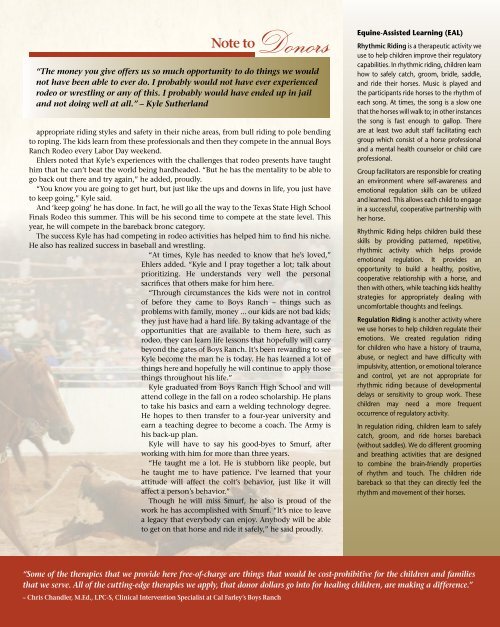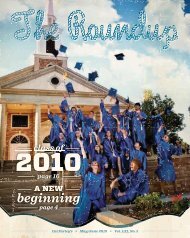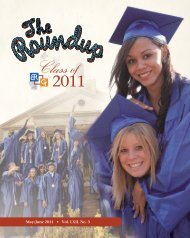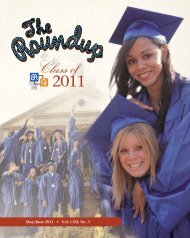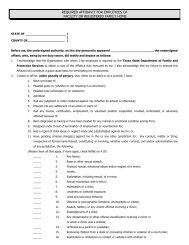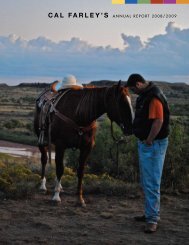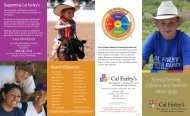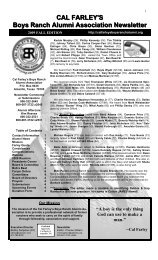The Roundup Summer 2012 - Cal Farley's
The Roundup Summer 2012 - Cal Farley's
The Roundup Summer 2012 - Cal Farley's
You also want an ePaper? Increase the reach of your titles
YUMPU automatically turns print PDFs into web optimized ePapers that Google loves.
Note to Donors“<strong>The</strong> money you give offers us so much opportunity to do things we wouldnot have been able to ever do. I probably would not have ever experiencedrodeo or wrestling or any of this. I probably would have ended up in jailand not doing well at all.” – Kyle Sutherlandappropriate riding styles and safety in their niche areas, from bull riding to pole bendingto roping. <strong>The</strong> kids learn from these professionals and then they compete in the annual BoysRanch Rodeo every Labor Day weekend.Ehlers noted that Kyle’s experiences with the challenges that rodeo presents have taughthim that he can’t beat the world being hardheaded. “But he has the mentality to be able togo back out there and try again,” he added, proudly.“You know you are going to get hurt, but just like the ups and downs in life, you just haveto keep going,” Kyle said.And ‘keep going’ he has done. In fact, he will go all the way to the Texas State High SchoolFinals Rodeo this summer. This will be his second time to compete at the state level. Thisyear, he will compete in the bareback bronc category.<strong>The</strong> success Kyle has had competing in rodeo activities has helped him to find his niche.He also has realized success in baseball and wrestling.“At times, Kyle has needed to know that he’s loved,”Ehlers added. “Kyle and I pray together a lot; talk aboutprioritizing. He understands very well the personalsacrifices that others make for him here.“Through circumstances the kids were not in controlof before they came to Boys Ranch – things such asproblems with family, money ... our kids are not bad kids;they just have had a hard life. By taking advantage of theopportunities that are available to them here, such asrodeo, they can learn life lessons that hopefully will carrybeyond the gates of Boys Ranch. It’s been rewarding to seeKyle become the man he is today. He has learned a lot ofthings here and hopefully he will continue to apply thosethings throughout his life.”Kyle graduated from Boys Ranch High School and willattend college in the fall on a rodeo scholarship. He plansto take his basics and earn a welding technology degree.He hopes to then transfer to a four-year university andearn a teaching degree to become a coach. <strong>The</strong> Army ishis back-up plan.Kyle will have to say his good-byes to Smurf, afterworking with him for more than three years.“He taught me a lot. He is stubborn like people, buthe taught me to have patience. I’ve learned that yourattitude will affect the colt’s behavior, just like it willaffect a person’s behavior.”Though he will miss Smurf, he also is proud of thework he has accomplished with Smurf. “It’s nice to leavea legacy that everybody can enjoy. Anybody will be ableto get on that horse and ride it safely,” he said proudly.Equine-Assisted Learning (EAL)Rhythmic Riding is a therapeutic activity weuse to help children improve their regulatorycapabilities. In rhythmic riding, children learnhow to safely catch, groom, bridle, saddle,and ride their horses. Music is played andthe participants ride horses to the rhythm ofeach song. At times, the song is a slow onethat the horses will walk to; in other instancesthe song is fast enough to gallop. <strong>The</strong>reare at least two adult staff facilitating eachgroup which consist of a horse professionaland a mental health counselor or child careprofessional.Group facilitators are responsible for creatingan environment where self-awareness andemotional regulation skills can be utilizedand learned. This allows each child to engagein a successful, cooperative partnership withher horse.Rhythmic Riding helps children build theseskills by providing patterned, repetitive,rhythmic activity which helps provideemotional regulation. It provides anopportunity to build a healthy, positive,cooperative relationship with a horse, andthen with others, while teaching kids healthystrategies for appropriately dealing withuncomfortable thoughts and feelings.Regulation Riding is another activity wherewe use horses to help children regulate theiremotions. We created regulation ridingfor children who have a history of trauma,abuse, or neglect and have difficulty withimpulsivity, attention, or emotional toleranceand control, yet are not appropriate forrhythmic riding because of developmentaldelays or sensitivity to group work. <strong>The</strong>sechildren may need a more frequentoccurrence of regulatory activity.In regulation riding, children learn to safelycatch, groom, and ride horses bareback(without saddles). We do different groomingand breathing activities that are designedto combine the brain-friendly propertiesof rhythm and touch. <strong>The</strong> children ridebareback so that they can directly feel therhythm and movement of their horses.“Some of the therapies that we provide here free-of-charge are things that would be cost-prohibitive for the children and familiesthat we serve. All of the cutting-edge therapies we apply, that donor dollars go into for healing children, are making a difference.”– Chris Chandler, M.Ed., LPC-S, Clinical Intervention Specialist at <strong>Cal</strong> Farley’s Boys Ranch4


